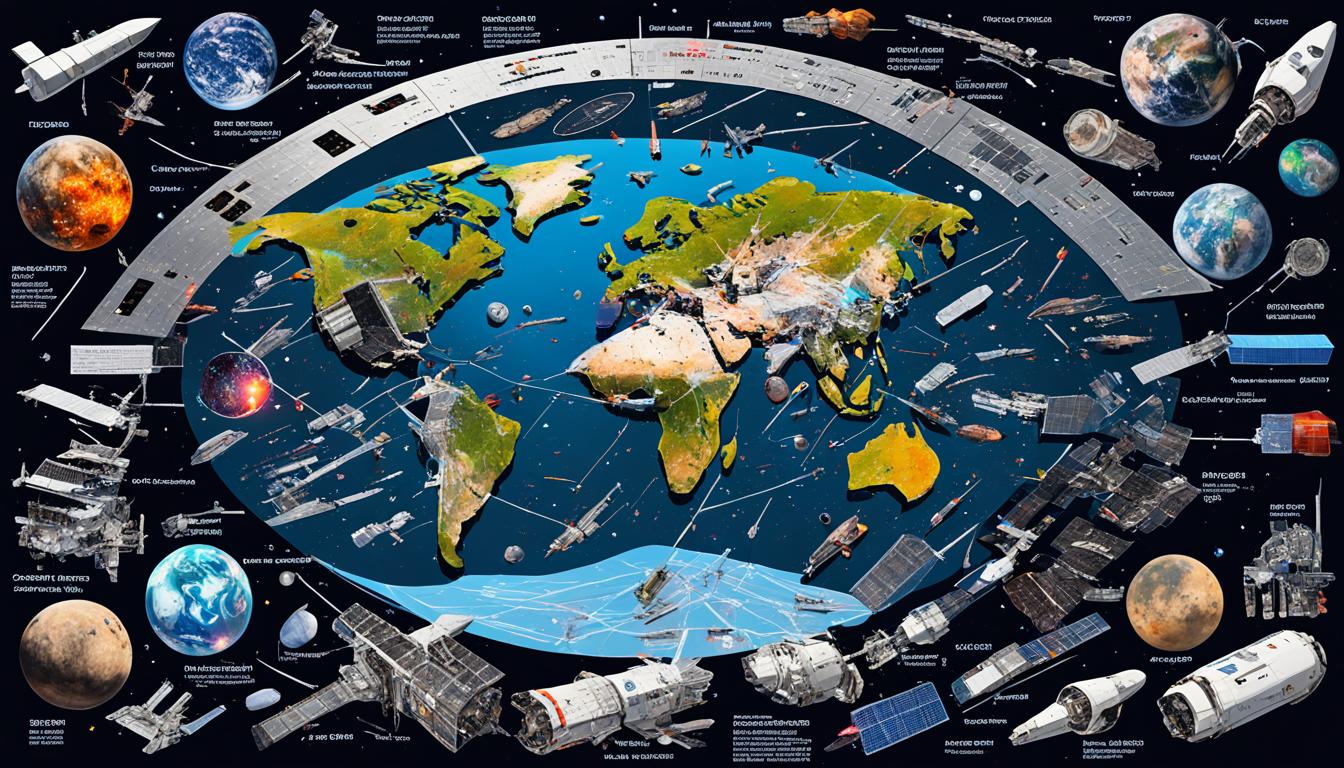
The Earth’s orbit is becoming increasingly cluttered with defunct satellites, spent rocket components, and other pieces of space debris, creating a hazardous environment for current and future space missions. Launch rates today are 10 times higher than they were 10 years ago, but compliance with space debris mitigation guidelines has not kept up. Even if we stopped launching any new missions today, the number of debris objects in orbit would continue to increase, potentially making some orbital regions unusable due to the high density of space debris. This threatens our shared future in space.
It is only a matter of time before human lives are lost because of a piece of space garbage. In the worst-case scenario, one collision could trigger a series of cascading collisions among pieces of junk and operational satellites, spreading orbital pollution widely and dangerously. This “Kessler Syndrome” scenario could make it impossible to launch satellites or humans to certain orbits. To prepare for the potential risks of space debris by 2025, individuals and organizations must take action to prevent collisions, remove the most dangerous debris, and establish rules to prevent the creation of new debris.
Key Takeaways
- The Earth’s orbit is increasingly cluttered with space debris, creating a hazardous environment for space missions.
- Space debris mitigation strategies are crucial to prevent collisions, remove dangerous debris, and establish rules to prevent new debris.
- Orbital debris tracking systems and space situational awareness programs are essential for monitoring and managing the growing space debris problem.
- Space traffic management regulations and satellite collision avoidance maneuvers are necessary to maintain a sustainable space environment.
- Space debris removal missions and initiatives are critical to addressing the long-term risks posed by orbital pollution.
Understanding the Growing Space Debris Problem
The Earth’s orbit is becoming increasingly congested with space debris, posing a significant threat to our future in space. As the number of satellites and human-made objects in orbit continues to rapidly increase, the space environment is being filled with millions of fast-moving debris particles, ranging from defunct satellites and spent rocket components to fragments of spacecraft.
What is Space Debris?
Space debris is defined as any non-functional, human-made object in orbit or reentering the Earth’s atmosphere. Since the dawn of the space age in 1957, we have launched nearly 50,000 tonnes of material into space, with only a fraction of it returning to Earth. Today, around 10,000 tonnes of this orbital debris remains in orbit, and on average, one object falls back to Earth uncontrolled each week.
Impact of Space Debris on Satellites and Spacecraft
The space debris problem poses a significant threat to active satellites and spacecraft in orbit. A collision with even a small 1 cm particle traveling at 10 km/s (of which there are about a million in orbit) can release the same energy as a small car crashing at 40 km/h. These high-speed impacts can severely damage or even destroy operational satellites and spacecraft, creating further space debris in a cascading effect.
The Kessler Syndrome and Cascading Collisions
The Kessler Syndrome is a concerning scenario where one collision triggers a series of cascading collisions among pieces of junk and operational satellites, spreading orbital pollution widely and dangerously. This could make certain crucial orbital regions entirely unusable, as the risks of collisions would become too high to launch satellites or send humans into space. Some experts argue that the Kessler Syndrome has already begun, with its effects unfolding over decades and centuries, much like the gradual build-up of space debris and the growing threat to the sustainability of our space environment.
Space Debris Mitigation Strategies
Preventing collisions requires careful tracking and, if necessary, a maneuver to avoid an impact. Traditionally, satellite operators have relied on data and alerts from the U.S. Air Force and Space Force, but the projections have been less than perfect. Companies like LeoLabs are now providing more rapid and accurate tracking of satellites and debris in orbit, with the ability to update positional information within minutes. Other companies, like Privateer, are developing sensor technology to track debris as small as a few centimeters. Improved space traffic management, including automated systems for collision avoidance, is crucial as the number of collision alerts and required maneuvers continues to grow.
Collision Avoidance Maneuvers
Collision avoidance, where a satellite is maneuvered out of the way of potential collisions, is now a regular part of flying missions in low-Earth orbit. This comes at a cost as fuel is required, and instruments are often turned off, meaning data is lost. With the dramatic rise in space activity and the growth in debris, the number of collision alerts and required maneuvers is increasing. Improved collision avoidance strategies, using automation, traffic coordination, and communication protocols, are needed to manage the growing risk of collisions.
Improved Orbital Clearance and End-of-Life Disposal
By reducing the time an object is in orbit, the smaller the chance it will collide with another object and create further debris. ESA’s “Zero Debris” approach proposes that the maximum time spent in protected low-Earth orbits at end of life for new missions be reduced from 25 years to just 5 years. There are also more stringent requirements for missions involving satellite constellations. Ensuring the safe disposal of space objects through atmospheric reentry or reorbiting to a safe altitude, with a high probability of success, is crucial for maintaining a sustainable space environment.
Preventing Accidental and Intentional Debris Release
Recommendations emphasize the need to prevent satellites from breaking up from within, caused by system explosions from leftover fuel or energy. Enhanced health monitoring and robust passivation techniques should be implemented. Additionally, the intentional release of any “Mission Related Objects,” such as protective covers, lens caps, and rocket fairings, should be minimized to prevent further debris growth. Standardized tools and methodologies should be developed to assess the risks of reentering objects and verify that missions are designed for proper demise at end of life.

How can I prepare for the potential risks of space debris by 2025?
To prepare for the potential risks of space debris by 2025, individuals and organizations must first increase their space debris awareness and understanding of the growing space debris problem and its implications. This includes educating the public, policymakers, and the space industry about the threat of space debris, the Kessler Syndrome, and the urgency of mitigating the issue. Raising space debris awareness will help drive the necessary actions and support for space sustainability initiatives and space environment preservation.
Supporting Space Debris Removal Initiatives
In addition to space debris education, individuals and organizations can support the development and implementation of space debris removal initiatives. This includes advocating for and funding research and demonstrations of active debris removal technologies, such as lasers, robotic arms, and drag sails. Supporting the establishment of reliable and affordable active debris removal services by 2030 is crucial for maintaining a sustainable space environment.
Advocating for Stricter Regulations and International Cooperation
To prepare for the potential space debris risks by 2025, individuals and organizations should advocate for stricter space debris regulations and international cooperation to address the space debris problem. This includes supporting the development and implementation of space traffic management systems, as well as the establishment of clear rules and guidelines for the sustainable use of space, such as the prevention of intentional debris release and the timely satellite deorbiting at the end of their mission.
Conclusion
The growing problem of space debris poses significant risks to our future in space, including the potential for cascading collisions that could render crucial orbital regions unusable. To prepare for the potential risks of space debris by 2025, a multifaceted approach is required, involving the prevention of collisions, the removal of the most dangerous debris, and the establishment of stricter regulations and international cooperation.
By increasing space debris awareness and supporting space debris removal initiatives, individuals and organizations can play a crucial role in securing our future in space and preserving the long-term sustainability of our space environment. Through advocacy for sustainable space policies and greater international cooperation, we can work towards mitigating the risks of space debris and ensuring the safe and responsible use of our shared orbital environment.
The time to act is now. By taking proactive steps to address the space debris crisis, we can safeguard our ability to explore and utilize the vast opportunities that space has to offer, for the benefit of generations to come.
FAQ
What is space debris?
Space debris is defined as all non-functional, human-made objects, including no longer functioning spacecraft or fragments of them, in orbit or reentering Earth’s atmosphere.
How does space debris impact satellites and spacecraft?
A collision with a 1 cm particle traveling at 10 km/s (of which there are about a million in orbit) releases the same energy as a small car crashing at 40 km/h. These impacts can destroy satellites and spacecraft, creating further debris in a cascading effect.
What is the Kessler Syndrome?
The Kessler Syndrome is a scenario where one collision triggers a series of cascading collisions among pieces of junk and operational satellites, spreading orbital pollution widely and dangerously. This could make it impossible to launch satellites or humans to certain orbits because the risks of collisions would be too high.
How can space debris be tracked and monitored?
Preventing collisions requires careful tracking and, if necessary, a maneuver to avoid an impact. Companies like LeoLabs are now providing more rapid and accurate tracking of satellites and debris in orbit, with the ability to update positional information within minutes. Other companies, like Privateer, are developing sensor technology to track debris as small as a few centimeters.
What are satellite collision avoidance maneuvers?
Collision avoidance, where a satellite is maneuvered out of the way of potential collisions, is now a regular part of flying missions in low-Earth orbit. This comes at a cost as fuel is required, and instruments are often turned off, meaning data is lost. Improved collision avoidance strategies, using automation, traffic coordination, and communication protocols, are needed to manage the growing risk of collisions.
How can the build-up of space debris be mitigated?
By reducing the time an object is in orbit, the smaller the chance it will collide with another object and create further debris. ESA’s “Zero Debris” approach proposes that the maximum time spent in protected low-Earth orbits at end of life for new missions be reduced from 25 years to just 5 years. Ensuring the safe disposal of space objects through atmospheric reentry or reorbiting to a safe altitude, with a high probability of success, is crucial for maintaining a sustainable space environment.
How can individuals and organizations prepare for the potential risks of space debris by 2025?
To prepare for the potential risks of space debris by 2025, individuals and organizations must first increase their awareness and understanding of the growing space debris problem and its implications. This includes educating the public, policymakers, and the space industry about the threat of space debris, the Kessler Syndrome, and the urgency of mitigating the issue. Individuals and organizations can also support the development and implementation of space debris removal initiatives and advocate for stricter regulations and international cooperation to address the space debris problem.
